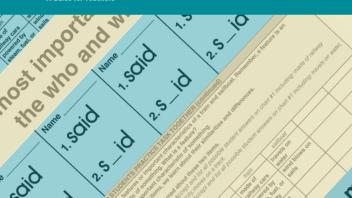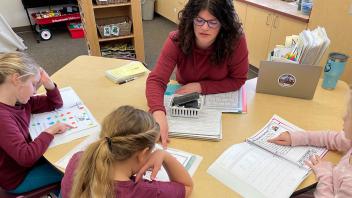Here are four examples of teacher-directed small group instruction in:
- Alphabet and Concepts of Print
- Decoding
- Fluency
- Reading Comprehension
Each plan emphasizes different components of reading and are designed to help students progress along the literacy continuum. Remember, not all components of reading are addressed within your small group time. The other components of reading and writing are addressed throughout the ELA block.
Most teachers allot between 10-20 min. to meet with each of their small groups. You may meet with every group every day or meet with varying groups on alternating days. Adjust the components and times to match the assessed needs of your students. Try to provide struggling readers with the lowest teacher/student ratio and the most time possible. Ideally, these students meet with you daily, regardless of any other interventions they receive — it’s the accumulated time, frequency and intensity of reading practice that helps struggling readers. If students have difficulty sustaining attention for more than 10-15 minutes, consider breaking components apart or giving students a short brain break.
Using the sample schedules
Read the explanations below to choose a planning template that best fits your students’ assessed needs. All of the times in each plan are suggestions — not hard and fast. Make adjustments to the components and times as needed to match the targeted needs of your students.
Focus on alphabet
Who needs this plan?
- Pre-reader or emergent reader
- Limited or no alphabet knowledge
- Rudimentary or limited phonological awareness skills
- Limited or some concepts of print
- Student’s writing may range from random marks/scribbles, using random numbers and letters and may lack left-right and top-bottom directionality.
- Some students on this plan may represent initial, final or salient sounds in words but spelling lacks vowels. Example: mop might be spelled: M, P, or MP.
- Student cannot decode words on their own.
- Student cannot read back their own writing, and sentences lack spaces between words.
When can I move on?
- When a student reads accurately and smoothly at or above Preprimer B with minimal teacher support.
- When a student knows about 10-12 or more letters of the alphabet.
- Student represents previously taught beginning and ending sounds consistently and begins to use a vowel in spelling.
- Student acquires concepts of print, e.g., able to track a text accurately or self-corrects tracking if s/he loses their place. Has directionality in reading.
Highlights of plan
- Focus is on teaching skills necessary for later reading: oral language, phonological awareness, and alphabet knowledge (letter names, sounds, and formation).
- Use rereading to foster concepts of print such as concept of word and directionality (L-R and top-bottom).
Focus on alphabet: sample schedule and activities
| Component | Estimated Time | Sample Activities |
|---|---|---|
| 3-5 min. |
|
| 5-8 min. |
|
| 2-3 min. |
|
| 5-10 min. | Before Reading: Introduce the title and elicit oral prediction. Teacher reads text aloud to students and models accurate tracking. Provide dots at the beginning of the line or under words to support tracking as needed. During Reading: Echo or choral read the text with teacher. Monitor for accurate tracking. After Reading: Ask students to read and track text (or selected part of text) on their own. Give students a sentence from text on a sentence strip. Point and reach each word. Cut apart into words. Mix and fix. |
| Total time | 10-20 min | Total time and components may vary across the week |
Focus on decoding
Who needs this plan?
- Student reads at or below a 1st grade level
- Fails to meet benchmark on an Oral Reading Fluency task
- Performs at or below a 1st grade level on timed graded word lists
- Student is learning to read and spell words with initial/final consonants, short vowels, digraphs/blends in closed syllables (CVC, CCVC, CVCC).
- Student is learning to read and spell high-frequency words.
When can I move on?
- When a student reads accurately and smoothly at or above a 1st grade level
- When a student masters most or all of the phonics features for the closed syllable
- When a student no longer needs to focus on decoding each word and has developed a sight word vocabulary
Highlights of plan
- Focus is on teaching decoding and word level skills: phonemic awareness, explicit phonics, and developing a sight word vocabulary.
- Use rereading to foster accurate and automatic word identification. Students may reread books 3-5x before retiring texts. Provide text-only versions of texts to remove picture supports and support decoding once a text is familiar/fluent.
- Teacher-directed reading — use decodable texts to apply phonics skills previously taught. Focus on accurate word recognition.
Focus on decoding: sample schedule and activities
| Component | Estimated Time | Sample Activities |
|---|---|---|
| 2-3 min. |
|
| 3-5 min. |
|
| 5-10 min. |
|
| 2-3 min. |
|
| 5-10 min. | Before Reading: Introduce the title and make a prediction. Remind student of decoding strategies that can be used. Set the purpose for reading. During Reading: Wait 3-5 seconds and correct all miscues with student. Encourage accurate reading. After Reading: Check student prediction and do a response activity. Examples:
|
| Total time | 10-20 min | Total time and components may vary across the week |
Focus on fluency
Who needs this plan?
- Student reads between a 1st and 3rd grade instructional level
- Student reads accurately but too slowly for age norms
- Student is learning to read and spell words with common and less frequent vowel patterns (VCe, Vowel teams, R-controlled, etc.) in the stressed syllable and can read many multisyllabic words.
When can I move on?
- Students who read at or beyond a 4th grade level with accurate, quick, and smooth/expressive reading can move to the next plan.
- Note: Students who read above 3rd grade but whose decoding skills are lagging may need to stay on this plan longer, especially if they read at/below 100wpm.
Highlights of plan
- Focus of effort is on developing fluency: accuracy, reading rate, expression, phrasing, and building stamina to read longer, more complex texts.
- Focus of effort is on supporting reading comprehension with teacher guidance.
Focus on fluency: sample schedule and activities
| Component | Estimated Time | Sample Activities |
|---|---|---|
| 3-5 min. | Choose one:
|
| 5-10 min. |
|
| 8-10 min. | Before Reading: Set a purpose for reading.
During Reading: Monitor and make repairs.
After Reading: Discuss and respond.
|
| Total time | 10-20 min | Total time and components may vary across the week |
Focus on comprehension
Who needs this plan?
- Student reads at 4th grade level or beyond
- Student reads accurately and smoothly for age norms (120wpm+)
- Student reads and spells multisyllabic words and learns common syllable patterns, inflected endings, and derived spellings. Morphology is a large focus of their spelling/vocabulary instruction.
- Note: Does a student have a reading comprehension problem? If a student with poor comprehension is on this plan, then it may be due to insufficient prior knowledge, weak vocabulary, or other unknown language/linguistic causes. Be sure that word reading accuracy and reading rate (decoding and fluency) were ruled out as potential sources of the problem first!
Highlights of plan
- Focus instruction mostly on promoting reading comprehension, building vocabulary, and developing written response to texts.
- Encourage a close reading of the text.
- Comprehension strategies are reviewed, but the focus of reading is on building content knowledge about the topic.
Focus on comprehension: sample schedule and activities
| Component | Estimated Time | Sample Activities |
|---|---|---|
| N/A | Not required for this plan. |
| 5-10 min. |
|
You may opt to first do a 1-min oral to spot-check accuracy and prosody. | 10-15 min. | Before Reading: Set a purpose for reading.
During Reading: Monitor and make repairs.
After Reading: Discuss and respond.
|
| Total time | 10-20 min |
Learn more about small-group instruction
Guides and Toolkits
Intensive Interventions for Students Struggling in Reading and Mathematics
Guides and Toolkits
Using Instructional Routines to Differentiate Instruction: A Guide for Teachers
Curriculum and Instruction
16 Elements of Explicit Instruction
In the Classroom
Instructional Routines, Grouping, and the ELA Block
Right to Read
Differentiation Done Right: How “Walk to Read” Works
Shanahan on Literacy
To Group or Not to Group — That Is the Question
Shanahan on Literacy
What Should Small Group Reading Instruction Look Like?
Shanahan on Literacy
Do We Teach Decoding in Small Groups or Whole Class?
Differentiated Instruction







